A Wireless Magnetic Resonance Device for Optogenetic Applications in an Animal Model
Abstract
:1. Introduction
1.1. Overview
1.2. Tethered Optical Stimulations
1.3. The Untethered Optical-Stimulation Device: Battery-Powered and Battery-Free with Wireless Remote-Control Formats
1.3.1. Battery-Powered and Wireless Remote-Controlled Devices
1.3.2. Battery-Free and Wirelessly Powered Remote-Controlled Device
1.4. Principle and Rationale for Magnetic-Resonant Wireless Remote Control
2. Materials and Methods
2.1. Animals
2.2. Device
2.3. Behavioral Tasks
2.3.1. Open-Field Task: Motor Function and Anxiety Assessments
2.3.2. Zero-Maze Task
2.3.3. Elevated Plus Maze
2.3.4. Forced-Swimming Test
2.3.5. Conditioned Taste Aversion
2.3.6. Tail Suspension Test
2.3.7. Social Interaction Test
3. Results
3.1. Wireless Remote-Controlled Device Components: Electromagnetic Device, Power, Relay Device, Stimulator, Receiver, and Electrical Circuitry
3.2. Parameter Tests for Receivers, Magnetic Resonance Field, and Wireless Photostimulating Remote-Controlled Devices
3.3. Electromagnetic Field Tested with Color-Coded Mapping
3.4. Auto-Tracking the Receiver on the Brain for Locomotor Activity in the Magnetic Resonance Field
3.5. Open-Field Task and Zero Maze Used to Test Locomotor Activity and Anxiety
3.6. Elevated Plus Maze Task for Anxiety
3.7. Forced-Swimming Test for Depression
3.8. Conditioned Taste Aversion Learning
3.9. Tail Suspension Test
3.10. Social Interaction Test
3.11. An Example of Photo Stimulations for Testing Methamphetamine-Induced Conditioned Taste Aversion Learning
4. Discussion
4.1. Optogenetic Photostimulation Outcomes: Wireless Control of Behaviors in Various Behavioral Tasks
4.2. The Novel Wireless Remote Control: Its Applications and Advantages Compared to Other Devices
4.3. Limitations of the Present Wireless Remote-Controlled Device
5. Conclusions
6. Patents
Author Contributions
Funding
Acknowledgments
Conflicts of Interest
References
- Yizhar, O.; Fenno, L.E.; Davidson, T.J.; Mogri, M.; Deisseroth, K. Optogenetics in neural systems. Neuron 2011, 71, 9–34. [Google Scholar] [CrossRef] [Green Version]
- Gutruf, P.; Rogers, J.A. Implantable, wireless device platforms for neuroscience research. Curr. Opin. Neurobiol. 2017, 50, 42–49. [Google Scholar] [CrossRef]
- Goncalves, S.B.; Ribeiro, J.F.; Silva, A.F.; Costa, R.M.; Correia, J.H. Design and manufacturing challenges of optogenetic neural interfaces: A review. J. Neural Eng. 2017, 14, 041001. [Google Scholar] [CrossRef]
- Wentz, C.T.; Bernstein, J.G.; Monahan, P.; Guerra, A.; Rodriguez, A.; Boyden, E.S. A wirelessly powered and controlled device for optical neural control of freely-behaving animals. J. Neural Eng. 2011, 8, 046021. [Google Scholar] [CrossRef]
- Aravanis, A.M.; Wang, L.P.; Zhang, F.; Meltzer, L.A.; Mogri, M.Z.; Schneider, M.B.; Deisseroth, K. An optical neural interface: In vivo control of rodent motor cortex with integrated fiberoptic and optogenetic technology. J. Neural Eng. 2007, 4, S143–S156. [Google Scholar] [CrossRef]
- Kravitz, A.V.; Freeze, B.S.; Parker, P.R.; Kay, K.; Thwin, M.T.; Deisseroth, K.; Kreitzer, A.C. Regulation of parkinsonian motor behaviours by optogenetic control of basal ganglia circuitry. Nature 2010, 466, 622–626. [Google Scholar] [CrossRef] [Green Version]
- Liu, X.; Ramirez, S.; Pang, P.T.; Puryear, C.B.; Govindarajan, A.; Deisseroth, K.; Tonegawa, S. Optogenetic stimulation of a hippocampal engram activates fear memory recall. Nature 2012, 484, 381–385. [Google Scholar] [CrossRef] [Green Version]
- Fenno, L.; Yizhar, O.; Deisseroth, K. The development and application of optogenetics. Annu. Rev. Neurosci. 2011, 34, 389–412. [Google Scholar] [CrossRef]
- Wykes, R.C.; Heeroma, J.H.; Mantoan, L.; Zheng, K.; MacDonald, D.C.; Deisseroth, K.; Hashemi, K.S.; Walker, M.C.; Schorge, S.; Kullmann, D.M. Optogenetic and potassium channel gene therapy in a rodent model of focal neocortical epilepsy. Sci. Transl. Med. 2012, 4, 161ra152. [Google Scholar] [CrossRef] [Green Version]
- Belzung, C.; Turiault, M.; Griebel, G. Optogenetics to study the circuits of fear- and depression-like behaviors: A critical analysis. Pharmacol. Biochem. Behav. 2014, 122, 144–157. [Google Scholar] [CrossRef]
- Wang, H.L.; Qi, J.; Zhang, S.; Wang, H.; Morales, M. Rewarding Effects of Optical Stimulation of Ventral Tegmental Area Glutamatergic Neurons. J. Neurosci. 2015, 35, 15948–15954. [Google Scholar] [CrossRef] [PubMed] [Green Version]
- Ghosh, K.K.; Burns, L.D.; Cocker, E.D.; Nimmerjahn, A.; Ziv, Y.; Gamal, A.E.; Schnitzer, M.J. Miniaturized integration of a fluorescence microscope. Nat. Methods 2011, 8, 871–878. [Google Scholar] [CrossRef] [Green Version]
- Iwai, Y.; Honda, S.; Ozeki, H.; Hashimoto, M.; Hirase, H. A simple head-mountable LED device for chronic stimulation of optogenetic molecules in freely moving mice. Neurosci. Res. 2011, 70, 124–127. [Google Scholar] [CrossRef] [PubMed]
- Arfin, S.K.; Long, M.A.; Fee, M.S.; Sarpeshkar, R. Wireless neural stimulation in freely behaving small animals. J. Neurophysiol 2009, 102, 598–605. [Google Scholar] [CrossRef] [Green Version]
- Yeh, A.J.; Ho, J.S.; Tanabe, Y.; Neofytou, E.; Beygui, R.E.; Poon, A.S.Y. Wirelessly powering miniature implants for optogenetic stimulation. Appl. Phys. Lett. 2013, 103, 163701. [Google Scholar] [CrossRef]
- Moradi, M.; Naghdi, N.; Hemmati, H.; Asadi-Samani, M.; Bahmani, M. Effect of ultra high frequency mobile phone radiation on human health. Electron. Physician 2016, 8, 2452–2457. [Google Scholar] [CrossRef] [PubMed] [Green Version]
- Drossos, A.; Santomaa, V.; Kuster, N. The dependence of electromagnetic energy absorption upon human head tissue composition in the frequency range of 300–3000 MHz. IEEE Trans. Microw. Theory Tech. 2000, 48, 1988–1995. [Google Scholar]
- Montgomery, K.L.; Yeh, A.J.; Ho, J.S.; Tsao, V.; Mohan, I.S.; Grosenick, L.; Ferenczi, E.A.; Tanabe, Y.; Deisseroth, K.; Delp, S.L.; et al. Wirelessly powered, fully internal optogenetics for brain, spinal and peripheral circuits in mice. Nat. Methods 2015, 12, 969–974. [Google Scholar] [CrossRef] [Green Version]
- Tesla, N. Apparatus for Transmitting Electrical Energy. U.S. Patent No. 1,119,732, 12 January 1914. [Google Scholar]
- Brown, W.C. The history of power transmission by radio waves. IEEE Trans. Microw. Theory Tech. 1984, 32, 1230–1242. [Google Scholar] [CrossRef] [Green Version]
- Lin, J.C. A new IEEE standard for safety levels with respect to human exposure to radio-frequency radiation. IEEE Antennas Propag. Mag. 2006, 48, 157–159. [Google Scholar] [CrossRef] [Green Version]
- Kurs, A.; Karalis, A.; Moffatt, R.; Joannopoulos, J.D.; Fisher, P.; Soljacic, M. Wireless power transfer via strongly coupled magnetic resonances. Science 2007, 317, 83–86. [Google Scholar] [CrossRef] [Green Version]
- Porsolt, R.D.; Le, P.M.; Jalfre, M. Depression: A new animal model sensitive to antidepressant treatments. Nature 1977, 266, 730–732. [Google Scholar] [CrossRef]
- Kaidanovich-Beilin, O.; Lipina, T.; Vukobradovic, I.; Roder, J.; Woodgett, J.R. Assessment of social interaction behaviors. J. Vis. Exp. 2011, 48, 2473. [Google Scholar] [CrossRef]
- El, R.R.; Klement, S.; Salti, A.; Fritz, M.; Dechant, G.; Saria, A.; Zernig, G. Preventive role of social interaction for cocaine conditioned place preference: Correlation with FosB/DeltaFosB and pCREB expression in rat mesocorticolimbic areas. Front. Behav. Neurosci. 2012, 6, 8. [Google Scholar]
- Cheng, Z.; Jiang, X. A wireless charging system DIY design scheme. Appl. IC 2016, 33, 33–35. [Google Scholar]
- Kampasi, K.; Stark, E.; Seymour, J.; Na, K.; Winful, H.G.; Buzsaki, G.; Wise, K.D.; Yoon, E. Fiberless multicolor neural optoelectrode for in vivo circuit analysis. Sci. Rep. 2016, 6, 30961. [Google Scholar] [CrossRef] [Green Version]
- Kim, T.I.; McCall, J.G.; Jung, Y.H.; Huang, X.; Siuda, E.R.; Li, Y.; Song, J.; Song, Y.M.; Pao, H.A.; Kim, R.H.; et al. Injectable, cellular-scale optoelectronics with applications for wireless optogenetics. Science 2013, 340, 211–216. [Google Scholar] [CrossRef] [Green Version]
- Scharf, R.; Tsunematsu, T.; McAlinden, N.; Dawson, M.D.; Sakata, S.; Mathieson, K. Depth-specific optogenetic control in vivo with a scalable, high-density muLED neural probe. Sci. Rep. 2016, 6, 28381. [Google Scholar] [CrossRef] [Green Version]
- Kwon, K.Y.; Lee, H.M.; Ghovanloo, M.; Weber, A.; Li, W. Design, fabrication, and packaging of an integrated, wirelessly-powered optrode array for optogenetics application. Front. Syst. Neurosci. 2015, 9, 69. [Google Scholar] [CrossRef]
- Stark, E.; Eichler, R.; Roux, L.; Fujisawa, S.; Rotstein, H.G.; Buzsaki, G. Inhibition-induced theta resonance in cortical circuits. Neuron 2013, 80, 1263–1276. [Google Scholar] [CrossRef] [Green Version]
- Stark, E.; Roux, L.; Eichler, R.; Senzai, Y.; Royer, S.; Buzsaki, G. Pyramidal cell-interneuron interactions underlie hippocampal ripple oscillations. Neuron 2014, 83, 467–480. [Google Scholar] [CrossRef] [Green Version]
- Mabrouk, O.S.; Semaan, D.Z.; Mikelman, S.; Gnegy, M.E.; Kennedy, R.T. Amphetamine stimulates movement through thalamocortical glutamate release. J. Neurochem. 2014, 128, 152–161. [Google Scholar] [CrossRef] [Green Version]
- Vouimba, R.M.; Maroun, M. Learning-induced changes in mPFC-BLA connections after fear conditioning, extinction, and reinstatement of fear. Neuropsychopharmacology 2011, 36, 2276–2285. [Google Scholar] [CrossRef]
- Devinsky, O.; Morrell, M.J.; Vogt, B.A. Contributions of anterior cingulate cortex to behaviour. Brain 1995, 118 Pt 1, 279–306. [Google Scholar] [CrossRef]
- Okazaki, A.; Takagi, S. An optogenetic application of proton pump ArchT to C. elegans cells. Neurosci. Res. 2013, 75, 29–34. [Google Scholar] [CrossRef]
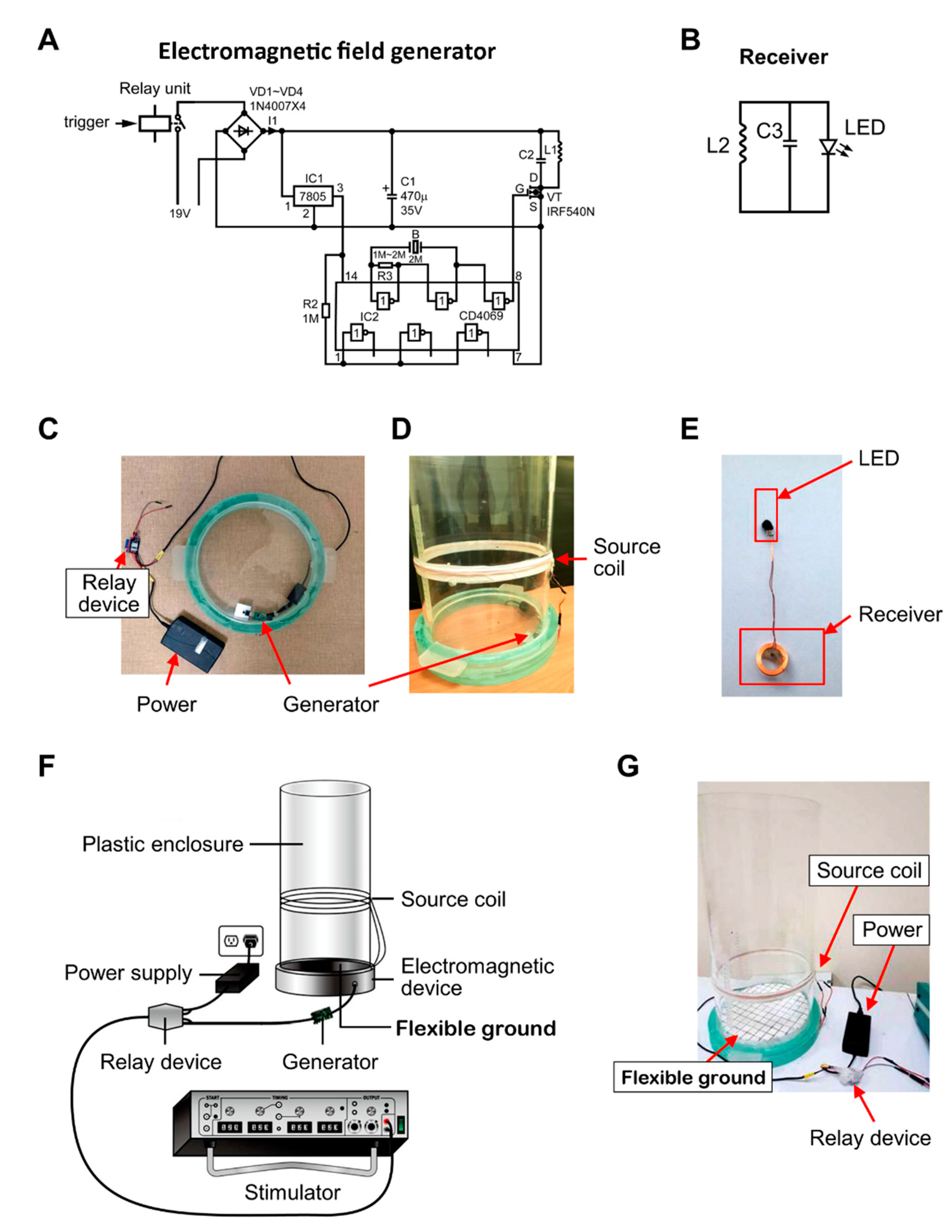

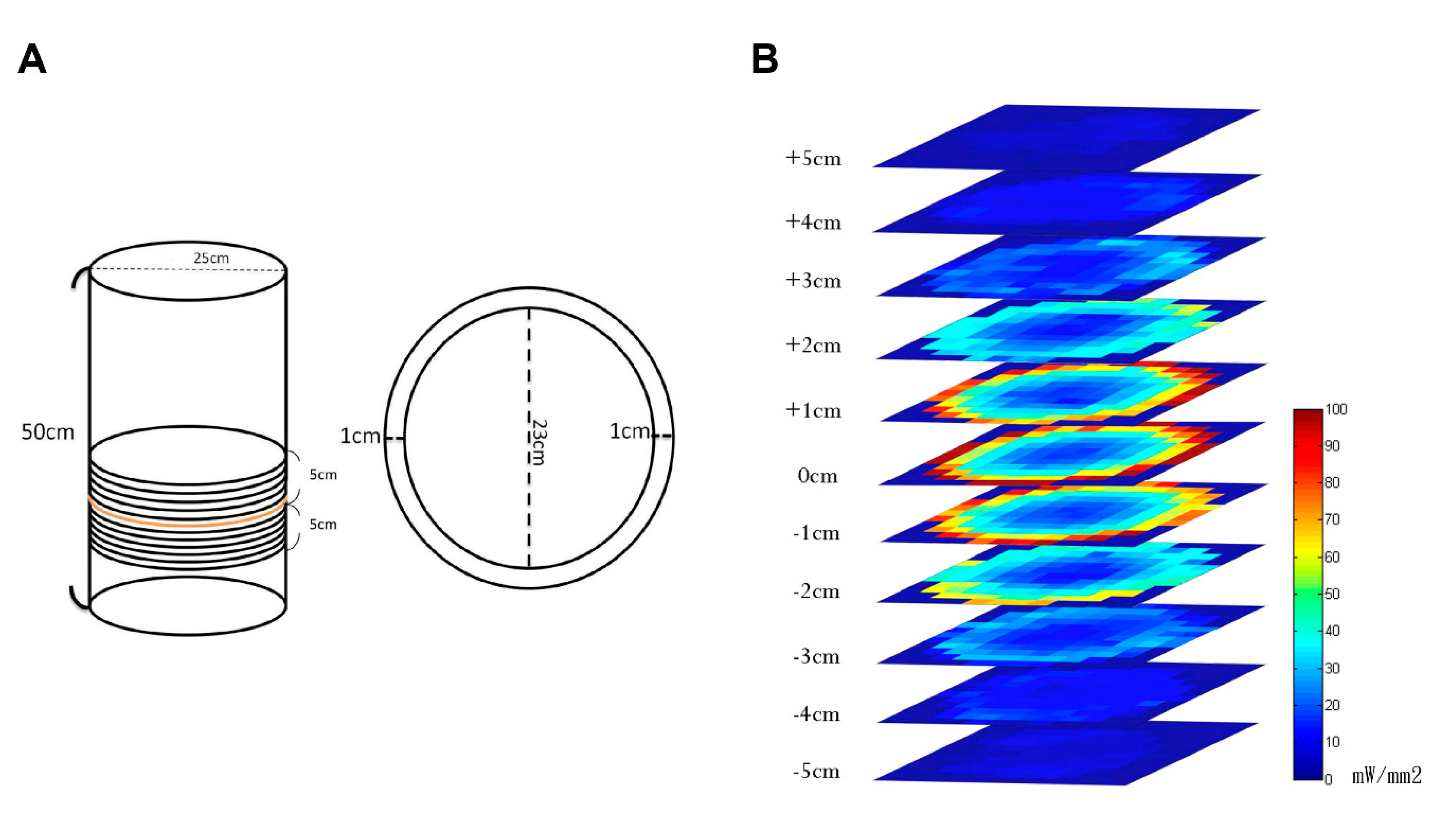
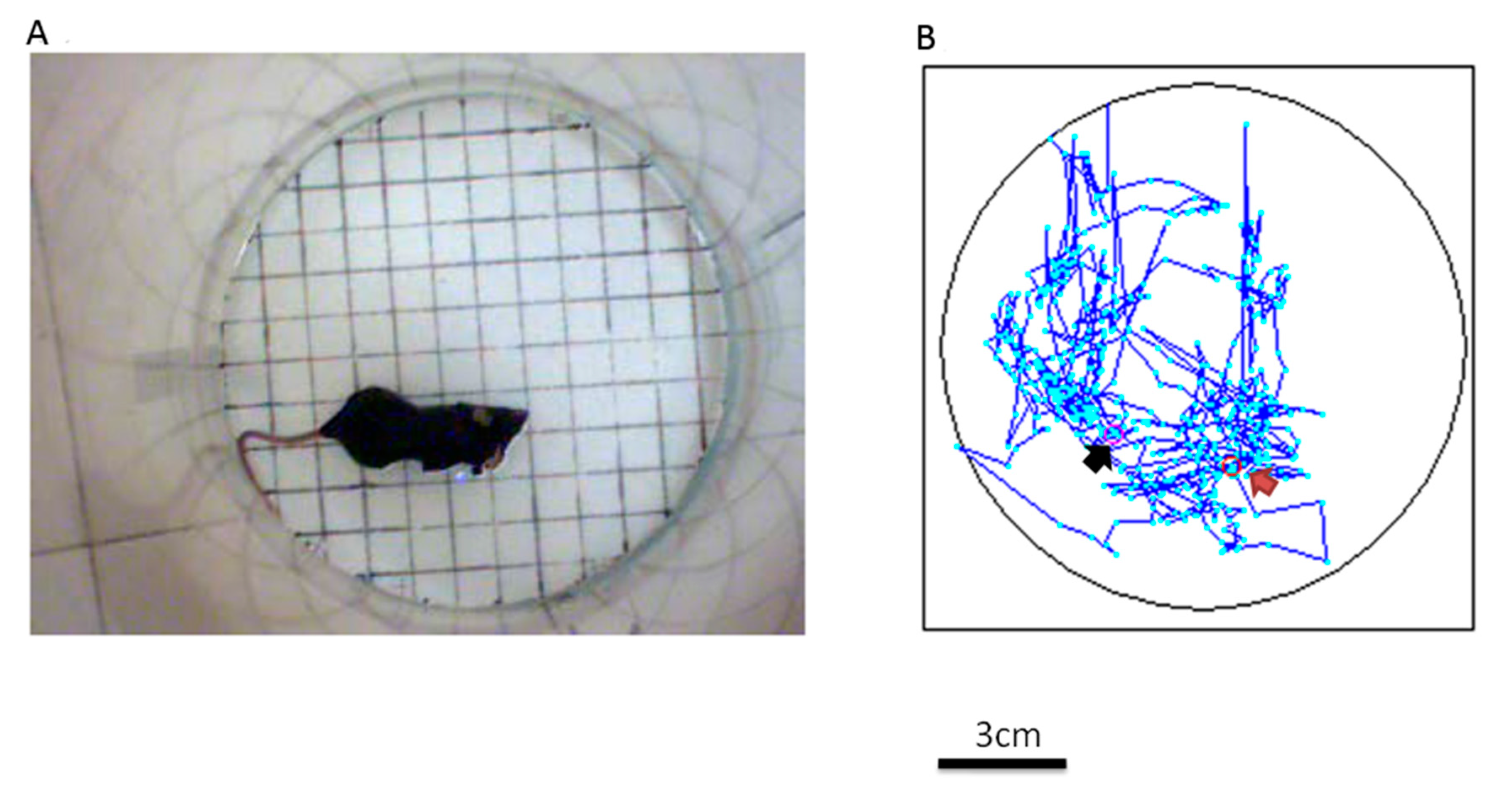
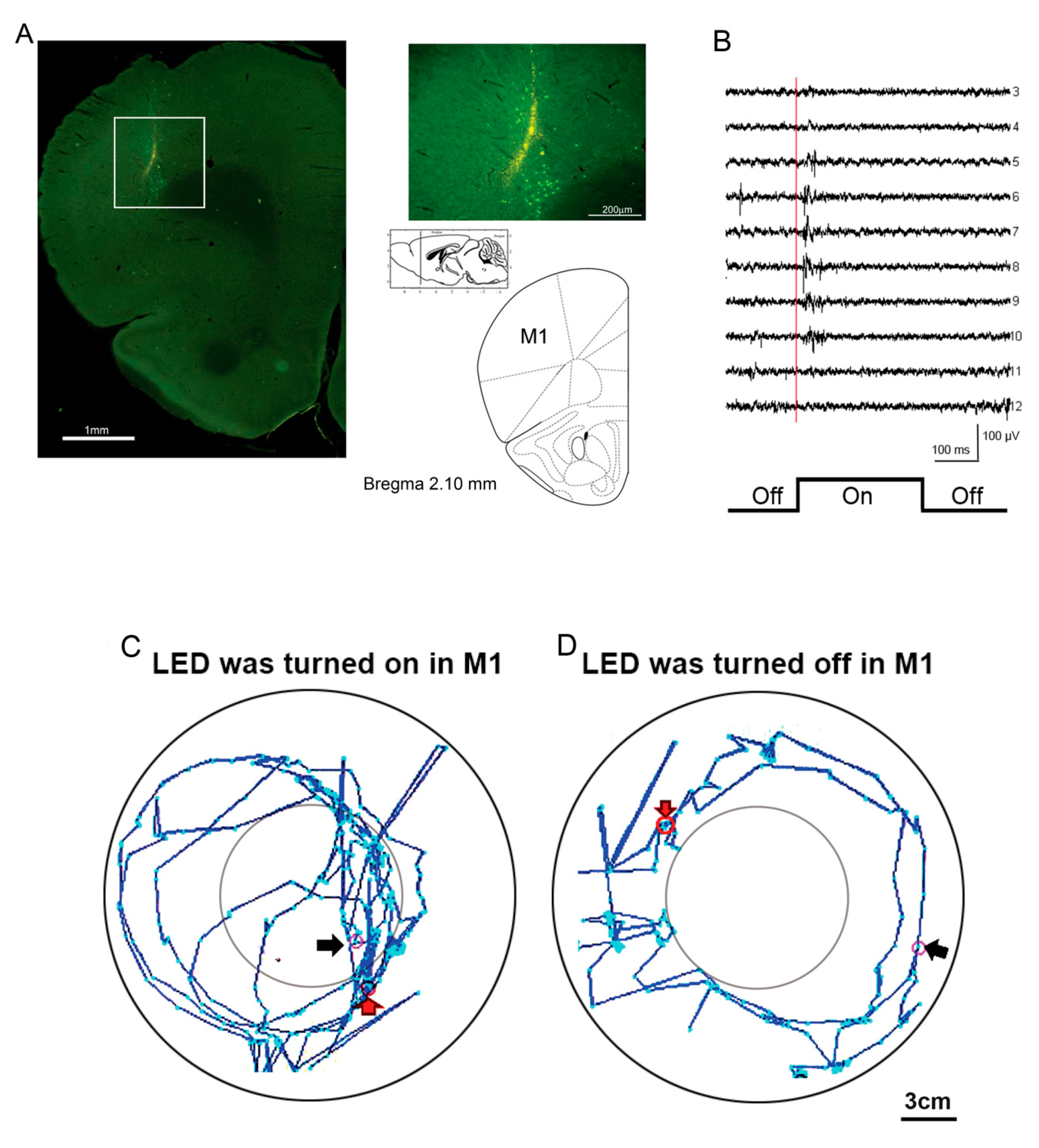
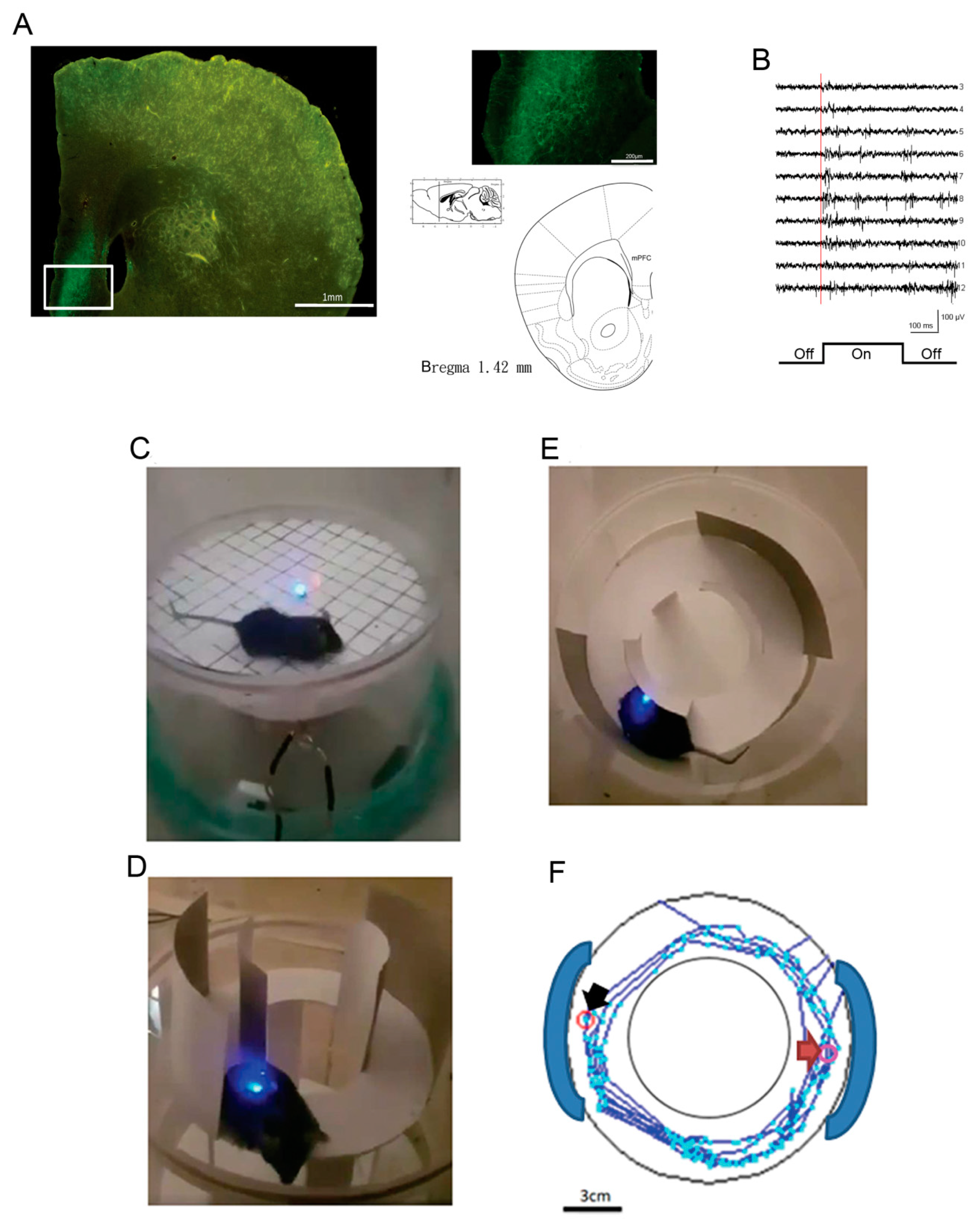
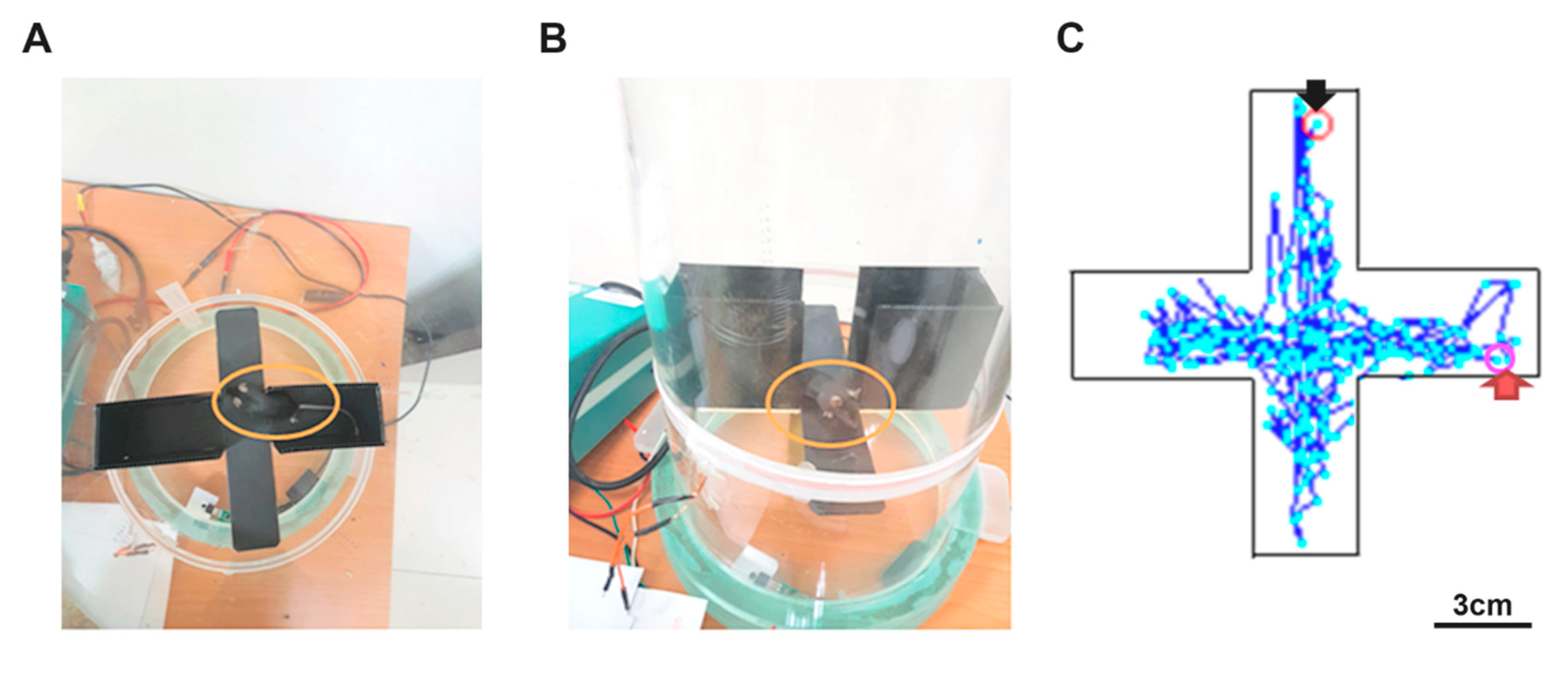



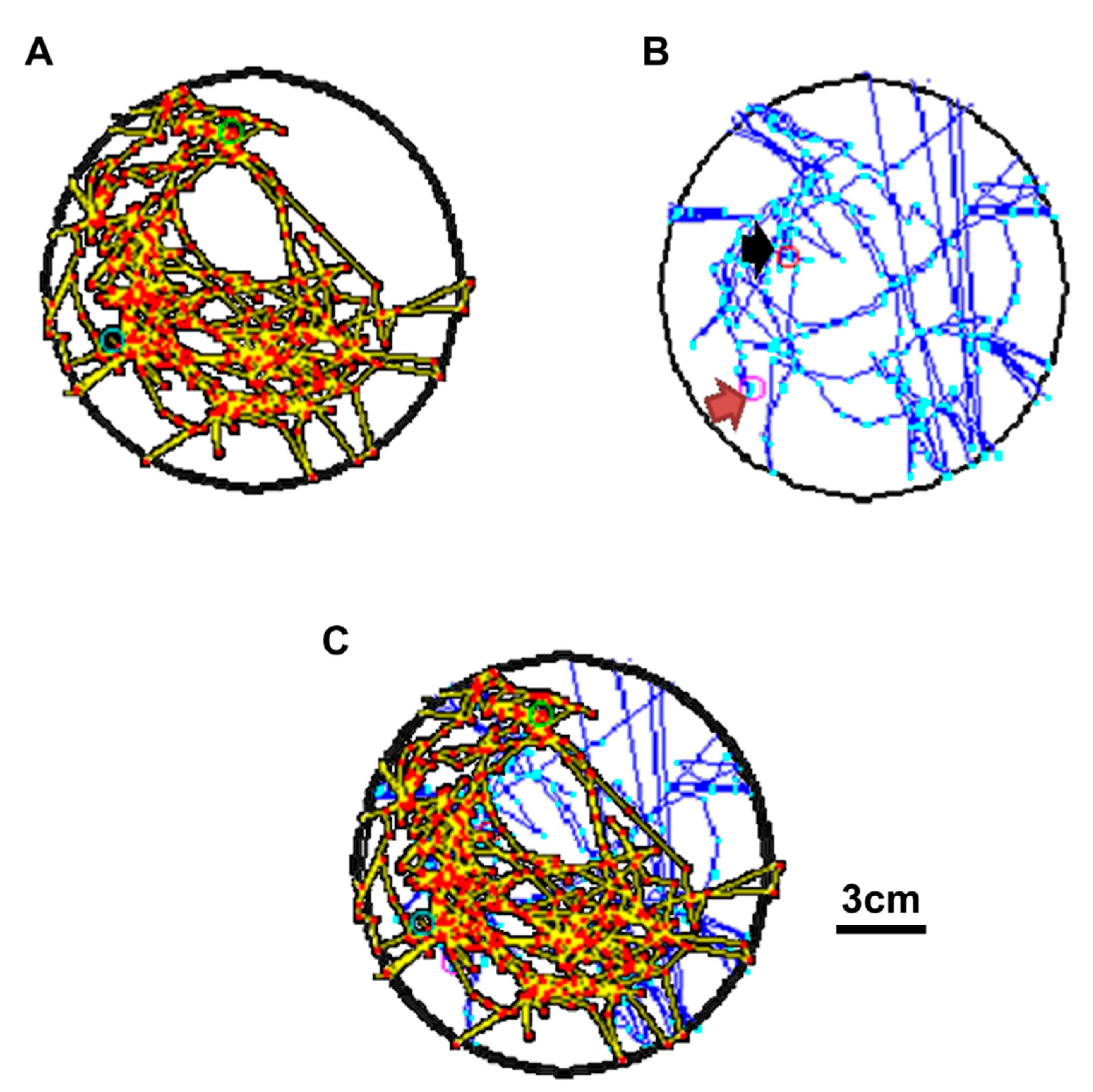
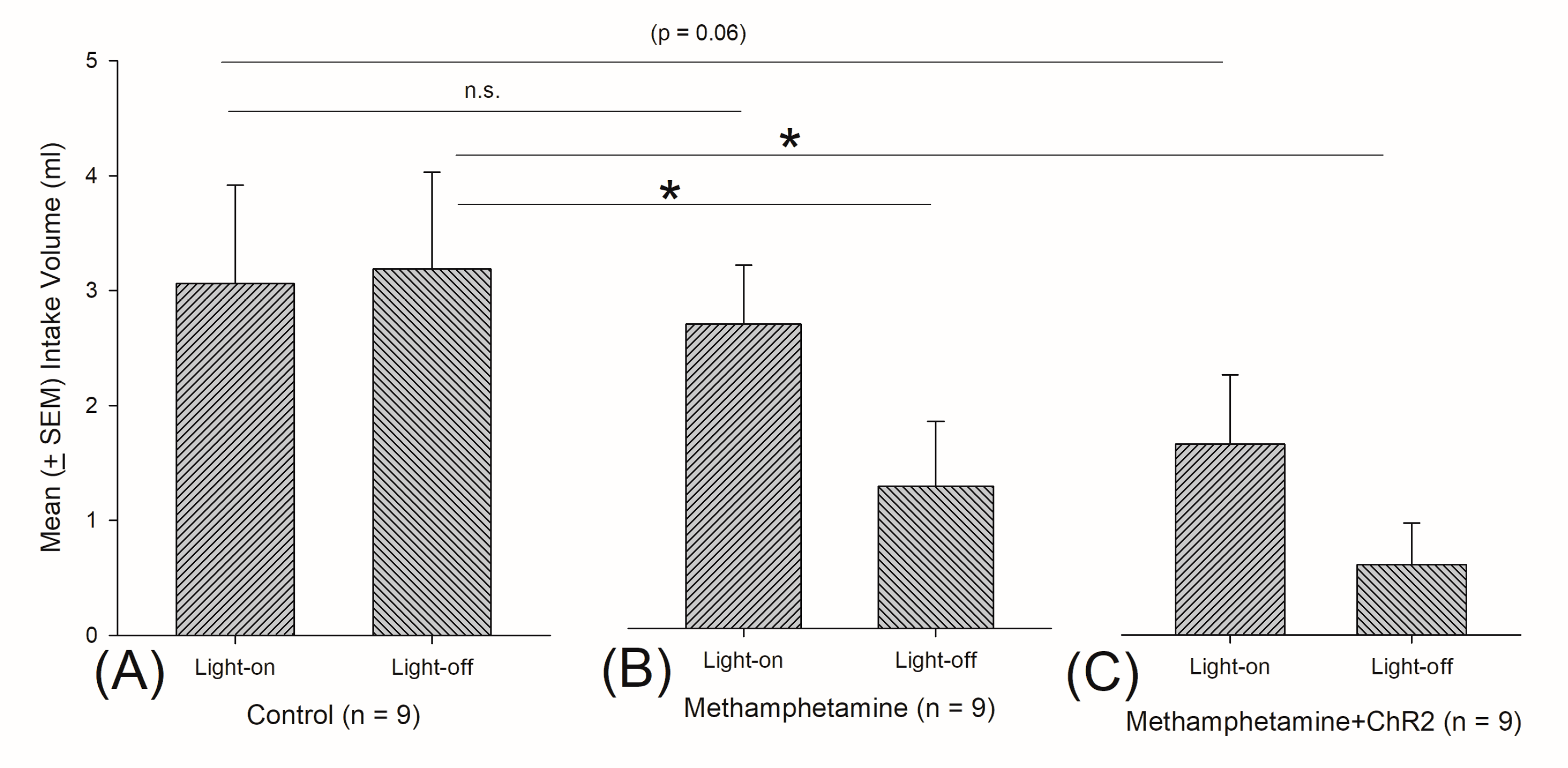
| Tethered Optical Stimulation | Untethered Optical Stimulation | |||
|---|---|---|---|---|
| Battery-Powered Device | Battery Free/Wireless-Powered Device | Our Wireless Magnetic Resonance Device | ||
| Advantage |
|
|
|
|
|
|
|
| |
|
|
| ||
| ||||
| ||||
| ||||
| ||||
| ||||
| Disadvantage |
|
|
|
|
|
| |||
| ||||
| ||||
| ||||
| ||||
Publisher’s Note: MDPI stays neutral with regard to jurisdictional claims in published maps and institutional affiliations. |
© 2020 by the authors. Licensee MDPI, Basel, Switzerland. This article is an open access article distributed under the terms and conditions of the Creative Commons Attribution (CC BY) license (http://creativecommons.org/licenses/by/4.0/).
Share and Cite
Tsai, A.C.; Huang, A.C.W.; Yu, Y.H.; Kuo, C.-S.; Hsu, C.-C.; Lim, Y.S.; Shyu, B.C. A Wireless Magnetic Resonance Device for Optogenetic Applications in an Animal Model. Sensors 2020, 20, 5869. https://doi.org/10.3390/s20205869
Tsai AC, Huang ACW, Yu YH, Kuo C-S, Hsu C-C, Lim YS, Shyu BC. A Wireless Magnetic Resonance Device for Optogenetic Applications in an Animal Model. Sensors. 2020; 20(20):5869. https://doi.org/10.3390/s20205869
Chicago/Turabian StyleTsai, Arthur C., Andrew Chih Wei Huang, Ying Hao Yu, Chii-Shyang Kuo, Chih-Chan Hsu, Yeou San Lim, and Bai Chuang Shyu. 2020. "A Wireless Magnetic Resonance Device for Optogenetic Applications in an Animal Model" Sensors 20, no. 20: 5869. https://doi.org/10.3390/s20205869
APA StyleTsai, A. C., Huang, A. C. W., Yu, Y. H., Kuo, C.-S., Hsu, C.-C., Lim, Y. S., & Shyu, B. C. (2020). A Wireless Magnetic Resonance Device for Optogenetic Applications in an Animal Model. Sensors, 20(20), 5869. https://doi.org/10.3390/s20205869







